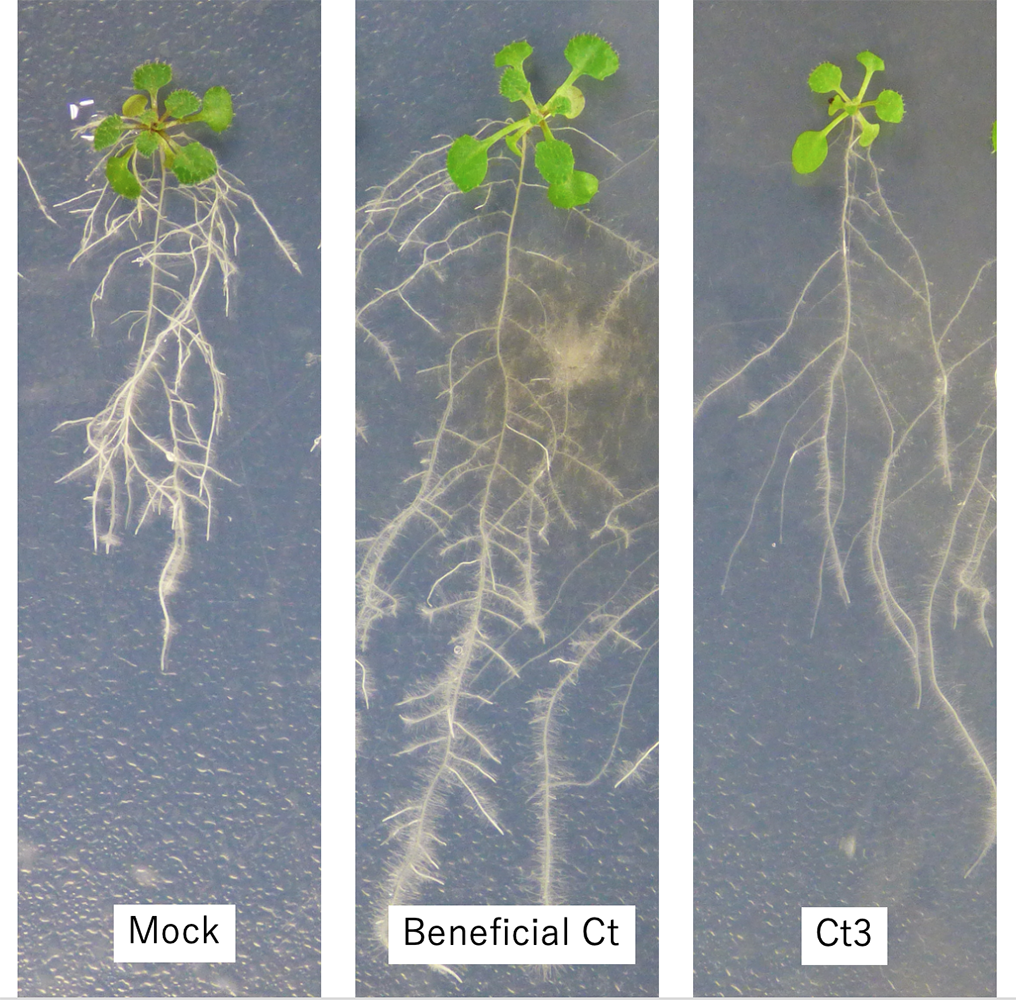Fruit and vegetable storage life can be significantly impacted by mold and fungi-based diseases. Some fungi, however, help their hosts by promoting plant survival. Root mold called Colletotrichum tofieldiae (Ct) often aids in plant growth even when it lacks phosphorus, a crucial ingredient for photosynthesis and growth. In contrast, the Ct3 pathogenic strain of the fungus, which was the subject of research, suppresses plant development.
 The effect of Colletotrichum tofieldae (Ct) on roots. These images show the startling effect of harmful Ct3 significantly limiting root growth, compared with beneficial Ct greatly increasing root growth of thale cress. Image Credit: 2023, K. Hiruma
The effect of Colletotrichum tofieldae (Ct) on roots. These images show the startling effect of harmful Ct3 significantly limiting root growth, compared with beneficial Ct greatly increasing root growth of thale cress. Image Credit: 2023, K. Hiruma
They discovered that the unfavorable effects of the fungus on the host plant were caused by the activation of a specific fungal secondary metabolism gene cluster by comparing the helpful and hazardous Ct strains.
The fungi’s behavior switched from preventing growth to supporting it when the cluster was damaged, either genetically or as a result of a change in the environment. By using the good effects that fungi can have on food, an understanding of systems like these could assist in reducing food waste.
It is always disheartening and unpleasant when fresh strawberries get moldy and fuzzy or when the grapes at the bottom of the fruit bowl turn gray and shrivel. The disease-causing fungus Botrytis, which decimates food crops all over the world and is easily transported by wind and soil, is usually to blame.
Numerous fungi, on the other hand, create alliances with their host plants that are less harmful and even promote the plant’s growth. Promoting the advantageous properties of fungus while suppressing negative effects (such as moldy fruit) would significantly contribute to global food security and help decrease a significant amount of food waste.
Plant-associated fungi show varied infection lifestyles ranging from mutualistic (beneficial) to pathogenic (harmful) depending on the host environment. However, the mechanisms by which these microbes transit along these different lifestyles remain poorly understood. We analyzed genetic information from varied strains of a root fungus called Colletotrichum tofieldiae using comparative transcriptomic analysis, which enabled us to study differences in gene expression between each strain.”
Kei Hiruma, Associate Professor, Graduate School of Arts and Sciences, University of Tokyo
Hiruma added, “Surprisingly, we found that a single fungal secondary metabolism gene cluster, called ABA-BOT, solely determines whether the fungus exhibits pathogenic or mutualistic traits toward the host plant.”
When plants are lacking in phosphorus, a fungus called Colletotrichum tofieldae helps them survive despite the lack of this essential nutrient. It has even been demonstrated to boost the development and output of commercially significant crops like maize and tomatoes.
Thale cress served as the study’s host plant, and the multi-institutional team infected it with six strains of Ct collected from various geographical regions. A sixth strain, known as Ct3, was discovered to limit nutrient intake, decreasing plant development and resulting in disease symptoms. Five strains dramatically enhanced plant growth, as was predicted. So, what brought about this abrupt change?
“We identified two key points: First, on the fungal side, that Ct3 activates the ABA-BOT biosynthesis gene cluster; and second, on the plant side, that Ct3 induces the host plant’s ABA signaling pathways, through which the fungus inhibits plant growth,” Hiruma stated.
The ABA-BOT gene cluster was discovered to be present in both pathogenic and mutualistic strains of Colletotrichum tofieldae. However, mutualistic strains did not express it, meaning the genes were not active. The conclusion surprised researchers since they had previously believed mutualists and pathogens to have different traits. However, these data point to a more complex relationship between the two.
The Ct3 became nonpathogenic and even helpful to the host by stimulating root development when the gene cluster was disrupted, either genetically or by altering the environment of the plant.
Despite the need for more research, it indicates that fungi other than the Ct species could also be affected by the ABA-BOT gene cluster’s potential role in pathogenesis. For instance, it could have a role in the etiology of the Botrytis disease that affects the fruits and vegetables that are consumed every day.
Hiruma noted, “If we gain a comprehensive understanding of the regulatory mechanisms governing the fungal secondary metabolism gene cluster, we can devise a method to selectively suppress potential pathogenesis in otherwise beneficial fungi, optimizing their utilization in agriculture and harnessing the full potential of the microbial diversity naturally present in soil ecosystems.”
“I have come to realize that even pathogens can exhibit nonharmful characteristics during a significant portion of their life cycles. In fact, I am beginning to contemplate the possibility that what we traditionally refer to as pathogens may actually function as beneficial microbes under other conditions,” Hiruma concluded.
Source:
Journal reference:
Hiruma, K., et al. (2023). A fungal sesquiterpene biosynthesis gene cluster critical for mutualist-pathogen transition in Colletotrichum tofieldiae. Nature Communications. doi.org/10.1038/s41467-023-40867-w.